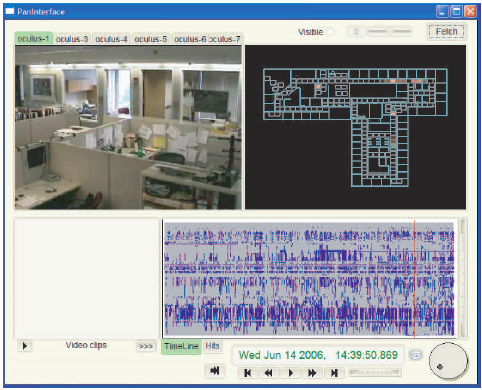TR2007-068
Visualizing the History of Living Spaces
-
- , "Visualizing the History of Living Spaces", IEEE Transactions on Visualization and Computer Graphics, Vol. 13, No. 6, pp. 1153-1160, November/December 2007.BibTeX TR2007-068 PDF
- @article{Ivanov2007nov,
- author = {Ivanov, Y. and Wren, C. and Sorokin, A. and Kaur, I.},
- title = {{Visualizing the History of Living Spaces}},
- journal = {IEEE Transactions on Visualization and Computer Graphics},
- year = 2007,
- volume = 13,
- number = 6,
- pages = {1153--1160},
- month = nov,
- issn = {1077-2626},
- url = {https://www.merl.com/publications/TR2007-068}
- }
- , "Visualizing the History of Living Spaces", IEEE Transactions on Visualization and Computer Graphics, Vol. 13, No. 6, pp. 1153-1160, November/December 2007.
-
Research Area:

Abstract:
The technology available to building designers now makes it possible to monitor buildings on a very large scale. Video cameras and motion sensors are commonplace in practically every office space, and are slowly making their way into living spaces. The application of such technologies, in particular video cameras, while improving security, also violates privacy. On the other hand, motion sensors, while being privacy-conscious, typically do not provide enough information for a human operator to maintain the same degree of awareness about the space that can be achieved by using video cameras. We propose a novel approach in which we use a large number of simple motion sensors and a small set of video cameras to monitor a large office space. In our system we deployed 215 motion sensors and six video cameras to monitor the 3,000-square-meter office space occupied by 80 people for a period of about one year. The main problem in operating such systems is finding a way to present this highly multidimensional data, which includes both spatial and temporal components, to a human operator to allow browsing and searching recorded data in an efficient and intuitive way. In this paper we present our experiences and the solutions that we have developed in the course of our work on the system. We consider this work to be the first step in helping designers and managers of building systems gain access to information about occupants' behavior in the context of an entire building in a way that is only minimally intrusive to the occupants' privacy.
Related News & Events
-
NEWS IEEE Transactions on Visualization and Computer Graphics: publication by MERL researchers and others Date: November 1, 2007
Where: IEEE Transactions on Visualization and Computer Graphics
Research Area: Computer VisionBrief- The article "Visualizing the History of Living Spaces" by Ivanov, Y., Wren, C., Sorokin, A. and Kaur, I. was published in IEEE Transactions on Visualization and Computer Graphics.
-
AWARD VIS 2007 Best Paper Award Date: January 1, 2007
Awarded to: Yuri Ivanov, Christopher Wren, Alexander Sorokin and Ishwinder Kaur
Awarded for: "Visualizing the History of Living Spaces"
Awarded by: IEEE Transactions on Visualization and Computer Graphics, IEEE Visualization Conference (VIS)
Research Area: Computer Vision